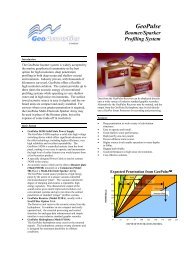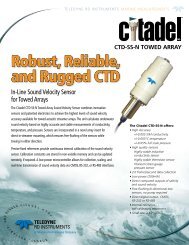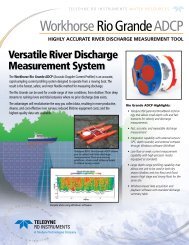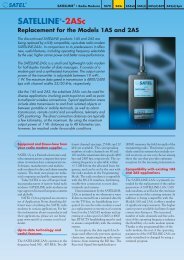- Page 1: DGPS MAXReference ManualPart Number
- Page 4 and 5: Copyright Notice© Copyright 2001 C
- Page 6 and 7: CSI Wireless Inc. Limited WarrantyC
- Page 8 and 9: Table of ContentsList of Figures ..
- Page 10 and 11: 3.2.1 Automatic Tracking ..........
- Page 12 and 13: 5.16.1 Changing the Source of DGPS
- Page 14 and 15: List of FiguresFigure 1-1 Broadcast
- Page 16 and 17: List of TablesTable 2-1 Power Requi
- Page 18 and 19: PrefaceWelcome to the DGPS MAX Refe
- Page 20 and 21: Appendix B: DGPS MAX Interface - pr
- Page 22 and 23: Document ConventionsBold is used to
- Page 25: 1. IntroductionThis chapter provide
- Page 29 and 30: ! Any data loss that occurs through
- Page 31 and 32: Augmentation Systems (SBAS). The DG
- Page 33 and 34: Figure 1-1 Broadcast WAAS Inonspher
- Page 35 and 36: Please note that signal coverage ma
- Page 37 and 38: geographically strategic locations.
- Page 39 and 40: Figure 1-5 Worldwide OmniSTAR Cover
- Page 41 and 42: ! Engine noise! Alternator noise! N
- Page 43 and 44: and for best results, a user should
- Page 45 and 46: 1.8 COAST TechnologyThe DGPS MAX re
- Page 47 and 48: 2. InstallationThis chapter contain
- Page 49 and 50: When selecting a location to instal
- Page 51 and 52: vehicle. Other grounds may provide
- Page 53 and 54: MAINExternal Device5 GND GND3 RX NM
- Page 55 and 56: the 1-14-UNS thread to a 5/8 th inc
- Page 57 and 58: 2.4.5 Connecting the CDA-2MAX Anten
- Page 59 and 60: 3. DGPS MAX OverviewFor your conven
- Page 61 and 62: tracking approach will result in mo
- Page 63 and 64: 3.4.1 Tune ModesThe DGPS MAX may be
- Page 65 and 66: 3.4.2 Receiver PerformanceThe Signa
- Page 67 and 68: 4. DGPS MAX ArchitectureThe DGPS MA
- Page 69 and 70: 5. OperationThis chapter introduces
- Page 71 and 72: % & ^No GPS Fix GPS Position DGPS P
- Page 73 and 74: Note - When using corrections from
- Page 75 and 76: In Figures 5-9 to 5-15, the root me
- Page 77 and 78:
^ 12332133312432 $444444444444 44F?
- Page 79 and 80:
is pressed. If is pressed, the menu
- Page 81 and 82:
5.7.3 Beacon Mode Bar ChartWhen ope
- Page 83 and 84:
WAAS@When this menu is accessed usi
- Page 85 and 86:
Top Menu@ When accessed using the b
- Page 87 and 88:
Longitude information is parsed fro
- Page 89 and 90:
Precision@NavCnd@ ABBABBAccessing t
- Page 91 and 92:
=_b: 0.1m This menu item indicates
- Page 93 and 94:
Eph?Healthy??8NotUsed?Prev?9Above?E
- Page 95 and 96:
Pressing the and keys allows you to
- Page 97 and 98:
5.9.2 GPS Satellites MenuThis secti
- Page 99 and 100:
5.9.3 GPS Configure MenuThis menu p
- Page 101 and 102:
GPGGA@?5?HzGPGGA@?1?HzGPGLL@?OffGPG
- Page 103 and 104:
GPRMC@ 1 HzGPRRE@ OffGPVTG@ 5 HzGPZ
- Page 105 and 106:
Top?Menu@ When accessed using the b
- Page 107 and 108:
the Back@ or Top Menu@ item in focu
- Page 109 and 110:
Back@ When accessed using the butto
- Page 111 and 112:
signal blockages, if present. This
- Page 113 and 114:
Back@ When accessed using the butto
- Page 115 and 116:
PositionTimeSat?UpdateThis menu ite
- Page 117 and 118:
modulation rate using the and keys
- Page 119 and 120:
This menu provides access to the si
- Page 121 and 122:
(SS) and signal to noise ratio (SNR
- Page 123 and 124:
ID?0001??H?01This menu item display
- Page 125 and 126:
When using an external source, be s
- Page 127 and 128:
Pressing the and keys allows you to
- Page 129 and 130:
Back@ When accessed using the butto
- Page 131 and 132:
item returns the menu system to the
- Page 133 and 134:
Top?Menu@ When accessed using the b
- Page 135 and 136:
Back@ or Top Menu@ item in focus wi
- Page 137 and 138:
! Depending on which baud rate you
- Page 139 and 140:
! Using the or key, move the Config
- Page 141 and 142:
6. Configuration WizardThe Configur
- Page 143 and 144:
6.1 Start-up SequenceWhen you turn
- Page 145 and 146:
6.6 Saving a ConfigurationWhen comp
- Page 147 and 148:
Table 7-1 NMEA Message ElementsElem
- Page 149 and 150:
Table 7-3 GGA Data Message DefinedF
- Page 151 and 152:
GST message into its components. Th
- Page 153 and 154:
7.5.7 RRE Data MessageThe RRE messa
- Page 155 and 156:
DGPS MAX Reference Manual 131
- Page 157 and 158:
• Check antenna connections• Ve
- Page 159 and 160:
ItemSerial Interface Specifications
- Page 161 and 162:
DGPS MAX Reference Manual 137
- Page 163 and 164:
MAINExternal Device5 GND GND3 RX NM
- Page 165 and 166:
! Connect Pin-5-Common Ground of th
- Page 167 and 168:
OmniSTAR Service ActivationYou may
- Page 169 and 170:
Over-Air Subscription ActivationOmn
- Page 171 and 172:
DGPS MAX Reference Manual 147
- Page 173 and 174:
! Adjust the output of the Bin96 me
- Page 175 and 176:
DGPS MAX Reference Manual 151
- Page 177 and 178:
Proximity, 4DGPS MAXRear Panel Inte
- Page 179:
Automatic Beacon Search (ABS),39, 4
















